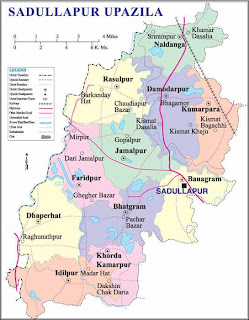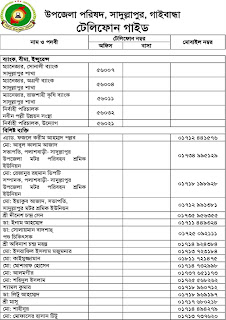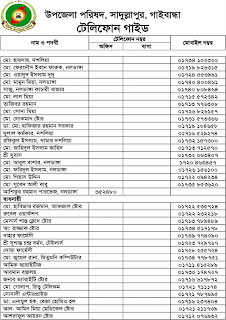Sadullapur (Town) consists of four mouzas. The area of the town is 6.38 sq km. It has a population of 10461; male 50.71% and female 49.29%; population density per sq km 1640. Literacy rate among the town people is 33.2%. The town has one dakbungalow.

Administration Sadullapur thana, now an upazila, was established in 1857. The upazila consists of 11 union parishads, 166 mouzas and 172 villages.
Historical events During the War of Liberation a direct encounter was held between the freedom fighters and the Pak army at Pirganj-Sadullapur border in which 21 members of the Pak army were killed
Marks of War of Liberation Memorial monument at the premises of the Sadullapur Muktijoddha Samsad.
Population 243012; male 50.4%, female 49.6%; Muslim 90.05%, Hindu 9.65%, Christian 0.02%, Buddhist 0.03% and others 0.25%.
Religious institutions Mosque 448, temple 32.
Literacy and educational institutions Average literacy 33.4%; male 42.5% and female 25.7%. Educational institutions: college 8, secondary school 48, junior school 5, madrasa 91, government primary school 90, non-government primary school 105, satellite school 10, KG school 2, community school 8. Noted educational institutions: Faridpur Government Primary School (1860), Molong Bazar Government Primary School (1884), Khurdo Komorpur High School (1915), Sadullapur Multilateral Pilot High School (1918), Naldanga Umesh Chandra High School (1946).
Cultural organisations Cinema hall 6, club 3, public library 2, theatre group 1, playground 30.
Main occupations Agriculture 47.97%, agricultural labourer 28.52%, wage labourer 2.75%, commerce 8.08%, service 3.29% and others 9.39%.
Land use Total cultivable land 18345 hectares, fallow land 5 hectares; char land 60 hectares; single crop 11.44%, double crop 76.45% and treble crop land 12.11%; cultivable land under irrigation 70%.
Land control Among the peasants 40% are landless, 34% small, 23% intermediate and 3% rich; cultivable land per head 0.07 hectare.
Value of land The market value of the land of the first grade is Tk 7500 per 0.01 hectare.
Main crops Paddy, jute, potato, turmeric, patal, and vegetables.
Extinct or nearly extinct crops Kaun, china, barley, and aus paddy.
Main fruits Mango, jackfruit, papaya, black berry and banana.
Fisheries, dairies, poultries Poultry 35, dairy 30, nursery (fish) 8, hatchery 2.
Communication facilities Roads: pucca 24 km, semi pucca 26 km and mud road 470 km; railways 12 km.
Traditional transport palanquin (extinct), horse carriage and bullock cart (nearly extinct), boat .
Manufactories Cold storage 1, biscuit factory 8, rice mill 30, saw mill 10 and welding 12.
Cottage industries 304 including handicraft, goldsmith, blacksmith, potteries, wood work, tailoring, etc.
Hats, bazars and fairs Hats and bazars are 23, most noted of which are Naldanga, Dhaper Hat, Sadullapur; fair 2 (Kalyanpur Mela, Pirerhat Mela).
Main exports Rice, paddy, turmeric, patal, potato and banana.
NGO activities Operationally important NGOs are brac, CARE, asa, proshika, Swanirvar Bangladesh, Ganakalyan Kendra, Save the Genesis and Gana Chetana.
Health centres Upazila health complex 1, union health centre 6, family welfare centre 10, satellite clinic 88








No comments:
Post a Comment